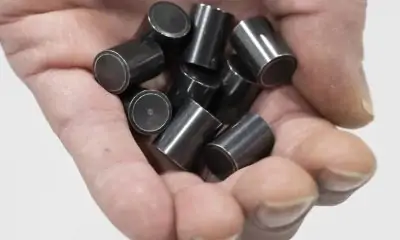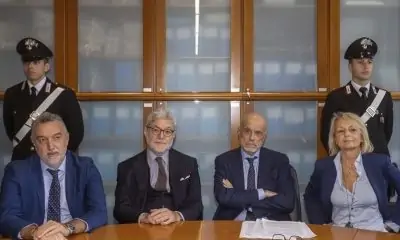OSHU CITY, Japan (AP) — Shohei Ohtani’s hometown in northern Japan is a rural place, famous for its high-quality Maesawa beef, its history of making traditional ironware and the intense green hills and mountains that surround it.
Japanese call such places “inaka” — roughly translated as the “countryside.” No glitz, quiet streets and up north — cold winters. It’s only 300 miles (500 kilometers) from Tokyo, but it seems further away.
These days, Oshu City is most famous for Ohtani himself, and the intense pride local people show for one of the game’s greatest ever players. He started in the local Little League with the Mizusawa Pirates, played for Hanamaki Higashi High School — a route that led him to the World Series. His Los Angeles Dodgers lead the New York Yankees 3-0, and fans here will be tuned in when LA tries to clinch the title early Wednesday morning local time.
The town honors Ohtani at every turn. And to experience it, start first with hairdresser Hironobu Kanno’s salon called “Seems.”
The hair salon that became a shrine to Shohei Ohtani
The waiting room is a museum dedicated to Ohtani with about 300 artifacts hung, stacked and squeezed into every corner. Even more items are in storage.
There are signed Dodgers and Angels jerseys, dozen of autographed baseballs, bats, shoes, caps, gloves, bobbleheads, photos of Othani and his wife Mamiko Tanaka, shirts emblazoned with images of his dog Decopin (Decoy in English), stuffed animals, pillows and life-size cutouts of the superstar.
Kanno said many fans come to town on a kind of “pilgrimage,” and his shop is often part of that.
“My customers and those who come to visit Ohtani’s hometown really enjoy seeing the collection, and I think it is a very effective way for them to feel closer to Ohtani,” he said.
The collecting began innocently when Kanno attended a baseball game on May 23, 2013 — the first professional game in which Ohtani batted and pitched. This was for Japan’s Hokkaido Nippon-Ham Fighters, and Kanno came back with a ball signed by Ohtani.
“When I put the ball with Ohtani’s autograph in my salon, the customers were very happy to see it,” Kanno said. “So I started to collect goods little by little.”
The rest is history.
He said his most treasured item is a cap signed by Japanese players who defeated the United States in the final of last year’s World Baseball Classic at the Tokyo Dome.
Nanno confessed that the cost of Ohtani goods keeps rising. He suggested he’d spent about 10 million yen — perhaps $100,000 — on Ohtani merchandise over a decade, and guessed the value might be five or six times as much.
He said he’d never met Ohtani nor his mother and father — Toru and Kayako — and the superstar has never seen the collection. He said eventually, he’d like to see it in a real museum and added he wasn’t in it for financial gain.
A small town becomes a pilgrimage point for the Ohtani-obsessed
Head across town to the city hall if you need more Ohtani memorabilia. One corner is loaded with photos of Ohtani, newspaper clips and pennants reminding that he won the American League MVP in 2023 and 2021. He’s the favorite to be the National League MVP this season.
The centerpiece of the city hall collection is a replica of Ohtani’s right hand. The golden hand allows you to grasp it and watch a video with Ohtani showing how the replica was made.
Keigo Kishino and his wife Chiaki said they traveled in one day from the western city of Osaka — by plane and train — just to shake the the hand.
“He is a source of energy for me, or something like that,” Chiaki said.
Jeffrey Kingston, who teaches history at Temple University in Japan, described Ohtani as a “combo of pure skill, pride and nationalism that make him irresistible to the Japanese public, and anyone remotely interested in the game, extending even to people who never really cared about baseball.”
His was referring partially to his wife Machiko Osawa, a professor of economics at Japan Women’s University. She is not a baseball fan. But Othani got her interested — at least in the short term.
“Ohtani changed the image of Japanese and helps transcend their complex feelings toward Westerners,” she explained.
“When I was young, there was a huge gap in ability between American players and Japanese players. Japanese players are shorter and not able to compete, but now Ohtani changed the image of Japanese baseball players. He is tall, fit and a superstar.”
Ohtani’s Oshu City impact is unlike any other ballplayer
Ohtani is the only MLB player from Oshu City, although others have come from nearby. Pitcher Yusei Kikuchi also attended Hanamaki Higashi High School, and Rintaro Sasaki — the son of Ohtani’s high school coach — is a phenom who skipped professional baseball in Japan altogether and currently plays at Stanford.
But no one generates buzz back home like Ohtani. Earlier this year, a local rice paddie was used as an “artist’s canvas” with Ohtani’s image in Dodger’s blue and wearing No. 17 — with Decoy alongside — cut into the green field. The likeness if unmistakable.
Oshu Mayor Jun Kuranari talked about Ohtani as an inspiration, and the rice paddie might be an example. He also brought up Ohtani as a role model.
“He plays with such a pure heart, and his performance is amazing,” the mayor said. “But what I think is also amazing is that he is able to stay humble while playing so well. He is a role model for everyone, and also makes the locals proud.”
___























